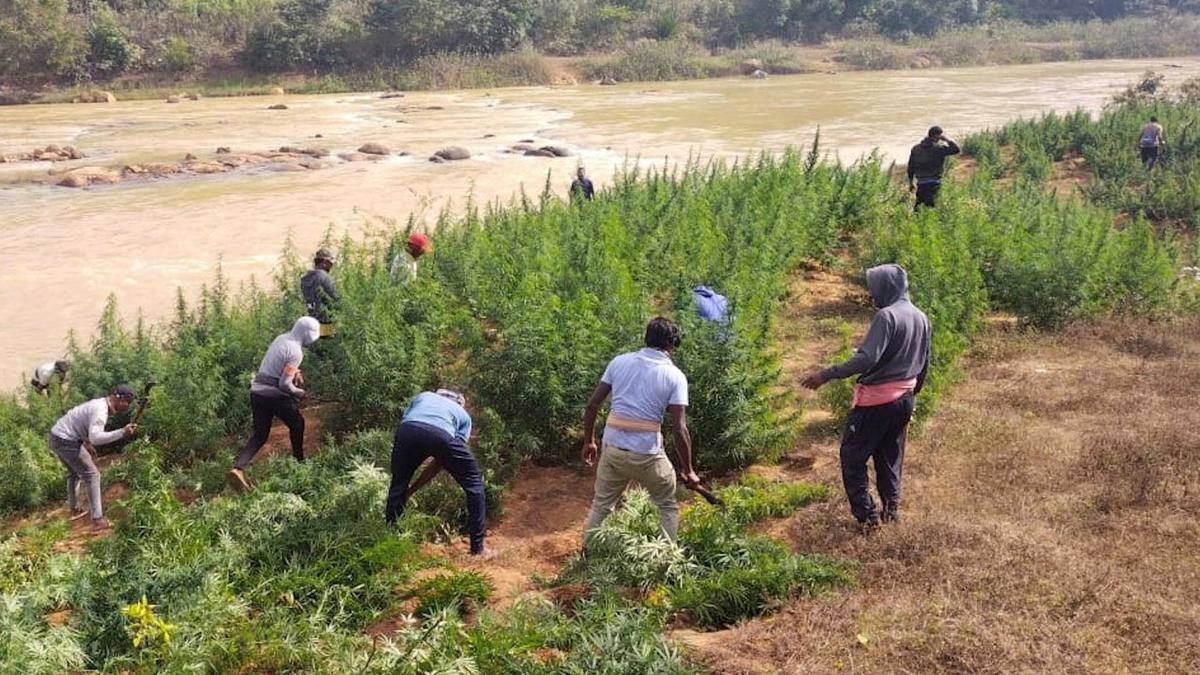Andhra Pradesh: space of ganja cultivation shrunk from 14,000 to 800 acres in ASR district, say police

Until about a number of months in the past, the newly-carved out district of Alluri Sitarama Raju, which was earlier a part of the Visakhapatnam district, was termed to be the ganja capital of the nation. It was stated that it was the biggest ganja producing district most likely after Chamba of Himachal Pradesh.
However as per the newest statistics given by the district police of ASR, publish the ganja eradication programme of the State Authorities known as ‘Parivarthana’, there may be enormous shrinkage within the complete space of cultivation within the district.
As per a conservative estimate of 2021, the weed or ganja or marijuana or hashish was being cultivated in about 13,000 to 14,000 acres of land, throughout the 9 Maoist-affected mandals of the district. And as per the newest survey, the cultivated space has now dropped right down to about 800 acres.
It was primarily grown within the mandals of GK Veedhi, Pedabayalu, Munchingput, G. Madugula and Chintapalli. And the districts, until a few 12 months in the past, had been reeling below the affect of the banned CPI (Maoists).
However since final 12 months, the district police below the rules of ‘Parivarthana’ programme had taken up a concerted effort for destruction of the crop.
“We’ve got been sporadically destroying the crop since the previous couple of years, however since final 12 months, we took it up scientifically after a correct drone and geo-mapping survey. We recognized the main cultivating areas and took up the destruction systematically,” stated Superintendent of Police, ASR district, S. Sathish Kumar.
Within the final 12 months alone the police and the Particular Enforcement Bureau (SEB) collectively destroyed ganja in about 7,500 acres, which was round 60% of the cultivated crop.
Final 12 months, the joint crew of the police and the SEB had been strongly opposed by the villagers. “We took up the destruction across the final week of October and continued until January- finish. However the resistance was primarily as a result of purpose that we had not knowledgeable the villagers and growers,” stated Mr. Sathish.
“However this 12 months, now we have taken care of it. The sowing season is from July to August and now we have began the notice marketing campaign from January, about six months early. Your entire 60% of the realm, which was destroyed final 12 months, had not grown the crop and the remaining have abstained from rising it on account of worry and discovering different crops reminiscent of ginger and turmeric, extra sustainable,” stated the SP.
As per DIG (Visakhapatnam Vary) S. Hari Krishna, this 12 months the strategy was a tad totally different from the earlier 12 months. “For the primary time now we have concerned the village sarpanches, ZPTCs, MPTCs, SHOs and the womenfolk, earlier than taking on the destruction. That paved the best way for clean destruction and folks coming ahead for the choice cropping sample. Final 12 months they’d complained that we should always have instructed them earlier than, in order that they might have opted for another crop. This 12 months, we didn’t give them that scope,” he stated.
This 12 months, the tribals who’ve abstained from ganja are rising rajma, turmeric and ginger.
However they demand that they be moved to espresso plantation. Espresso is a everlasting and sustainable crop and every acre can generate a income of round ₹1.3 lakh per 12 months. Nevertheless it takes a minimal of three to 4 years for the crop to develop.
“Initially, silver oaks should be planted, and as soon as these timber develop, espresso and pepper might be sowed. To start, now we have been offered about 4 lakh saplings of Silver Oaks, that are at present being nurtured in a nursery and can be planted round April subsequent 12 months. Espresso might be grown throughout all the Company, because the local weather and the soil is conducive and we’re making a starting to wean the tribals from ganja,” stated Mr. Sathish.
Big potential
If the crop was being grown in about 14,000 acres and the estimated common yield per acre is round 700 kg, then the quantity of enterprise within the cultivated space is near ₹1,000 crore, with one kg being valued at round ₹1,000 on the farmers’ finish. And when it reaches the metro cities, the enterprise expands to over ₹10,000 to ₹15,000 crore.
In accordance with the police, the ganja per kg which was priced at round ₹800 on the farmers’ place, has now gone as much as ₹2,500 and in Vizag it has gone up from ₹2,300 to ₹20,000 and in cities reminiscent of Hyderabad and Bengaluru it has gone up from ₹10,000 to over ₹40,000, which signifies that the shortage has begun, on account of profitable destruction of the crops and weaning the farmers away from taking it up, stated Mr. Sathish.
One purpose why the police and implementing company have been getting some success, is because of waning presence of the Maoists. Surrenders, arrests and encounters, have diminished their presence to nearly negligible stage, particularly within the 9 Company mandals of erstwhile Visakhapatnam district.




